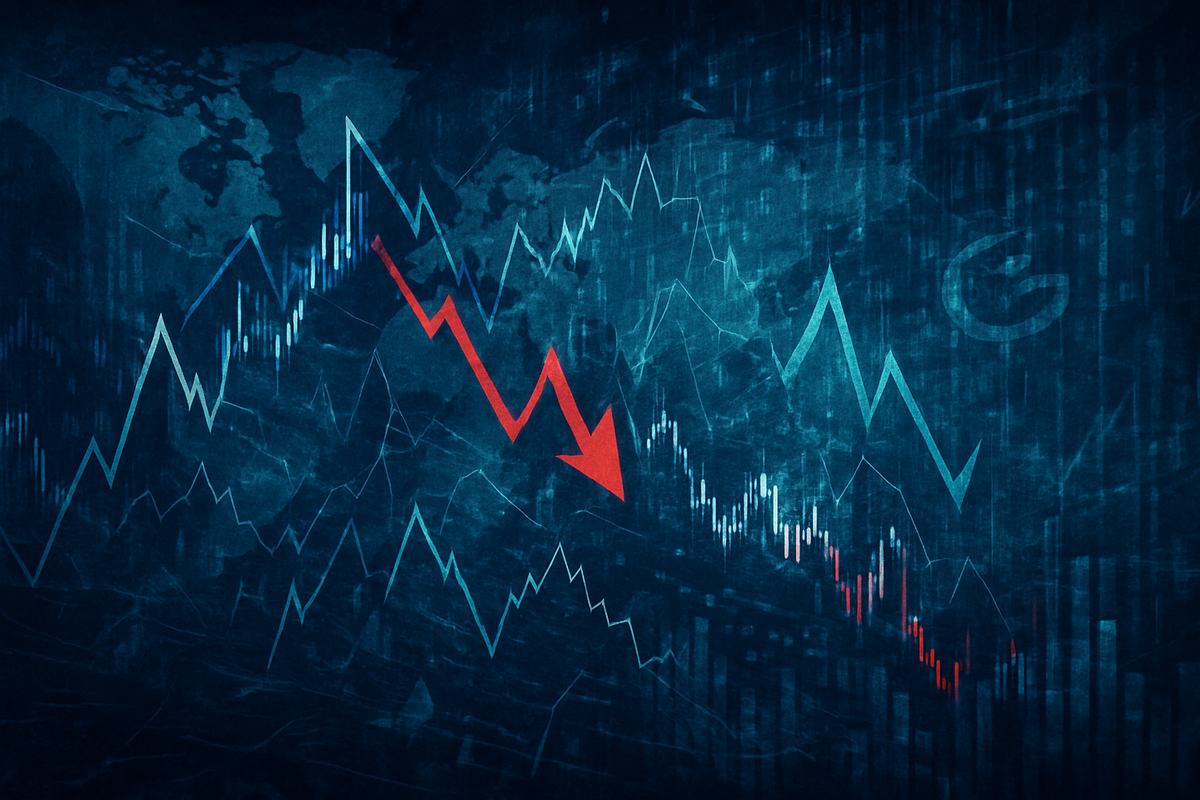
The global financial markets are currently gripped by a palpable sense of unease, as significant stock swings and heightened volatility define the investment landscape of late 2025. This turbulent period is primarily driven by a complex interplay of geopolitical tensions, evolving interest rate expectations, and lingering concerns over inflated valuations within key technology sectors. Investors and businesses alike are grappling with rapid shifts in sentiment, demanding agility and a keen understanding of the underlying forces at play.
The immediate implications are clear: increased investor caution, evident in the rising CBOE Volatility Index (VIX), and a rapid reassessment of corporate valuations. While some days bring sharp sell-offs, particularly in high-growth tech, others witness surprising rebounds, indicating a market caught between underlying economic resilience and a myriad of uncertainties. This environment necessitates a strategic approach to capital allocation and risk management, as the market navigates what many are calling a "new normal" of sustained turbulence.
A Year of Shocks and Realignments: The Detailed Story of Market Swings
The volatility observed around November 5, 2025, is not an isolated event but the culmination of a multi-year trend marked by significant economic and geopolitical shifts. The period from 2023 to late 2025 has been a rollercoaster, with inflation, central bank policy, and political changes dictating market direction.
A Volatile Timeline:
- 2023-2024: Inflation, Rates, and the "Magnificent Seven": The early part of this period saw global economies battling persistent inflation, with the US experiencing robust growth while inflation gradually cooled. Central banks, including the US Federal Reserve, European Central Bank (ECB), Bank of England (BoE), and Bank of Japan (BoJ), actively adjusted monetary policies. The Federal Reserve embarked on an aggressive rate-cutting cycle in late 2024 after earlier increases. Meanwhile, the US stock market was largely propelled by the "Magnificent Seven" – Alphabet (NASDAQ: GOOGL), Amazon (NASDAQ: AMZN), Apple (NASDAQ: AAPL), Meta Platforms (NASDAQ: META), Microsoft (NASDAQ: MSFT), Nvidia (NASDAQ: NVDA), and Tesla (NASDAQ: TSLA) – fueled by AI enthusiasm.
- Early 2025: Political Shifts and Trade Wars Emerge: The US presidential election in early 2025, resulting in a Republican-controlled administration, introduced substantial policy uncertainty. President Donald Trump's administration initiated assertive trade measures, including tariffs of 25% on autos and auto parts, 34% on Chinese goods, and 20% on EU products, sending shockwaves through global supply chains. Concurrently, the sudden emergence of China's affordable DeepSeek AI model challenged US tech dominance, leading to a sell-off in AI-related equities and a broadening of market leadership beyond the "Magnificent Seven." Consumer sentiment also soured, reaching its lowest since November 2022.
- Mid-2025: Geopolitical Escalations and S&P 500 Swings: Geopolitical dangers intensified with ongoing conflicts in Ukraine and the Middle East, along with rising tensions between China and Taiwan, contributing to global uncertainty. The S&P 500 experienced considerable volatility, with daily moves exceeding 2% more often than in the preceding two years. A temporary pause in tariffs on April 9 led to a 9.5% surge, but the persistent backdrop of policy and geopolitical risks continued to portend increased macroeconomic volatility.
- Near November 5, 2025: Earnings Season and Macro Concerns: The earnings season leading up to November 5, 2025, has been characterized by heightened volatility. Even strong earnings beats were sometimes met with initial declines due to "sky-high valuations" and "extremely high expectations," only to recover later. Investors continue to scrutinize economic indicators, geopolitical developments, and the pace of technological change.
Key Players and Stakeholders:
The current market dynamics involve a broad spectrum of influential entities:
- Central Banks: The Federal Reserve, ECB, BoE, and BoJ are pivotal, with their interest rate decisions and monetary policies directly impacting financial markets.
- Governments and Policymakers: National administrations, particularly the US, wield significant influence through trade policies (tariffs), fiscal policies, and regulatory changes.
- Institutional Investors: Hedge funds, pension funds, sovereign wealth funds, mutual funds, and insurance companies collectively manage vast capital, their investment decisions driving significant market movements.
- Commercial and Investment Banks: These institutions act as market makers, providing liquidity and facilitating trading.
- Large and Multinational Corporations: Their earnings, investment decisions, and responses to economic conditions profoundly shape market sentiment.
- Retail Investors: Individual investors contribute to market dynamics, with their sentiment often amplified during volatile periods.
- Regulatory Bodies: These bodies oversee financial markets to maintain stability and ensure compliance.
Initial Market Reactions:
The immediate reactions to this period of volatility have been varied:
- Heightened Volatility and Sell-offs: Markets have experienced sharp swings, with riskier assets often seeing significant sell-offs in response to trade measures and geopolitical escalations.
- Flight to Safety: Investors have frequently shifted towards perceived safe havens, such as gold, which has maintained a bullish outlook, and certain government bonds, though the latter's role was challenged by high yields in 2025.
- Increased Focus on Risk Management: Institutions and individual investors have prioritized reviewing hedging policies, optimizing treasury management, and enhancing cash flow forecasting.
- Sector Rotations: There has been a notable rotation out of growth and momentum stocks (like those in information technology and communication services) towards value-oriented and defensive sectors, including financials, industrials, and utilities.
- Re-evaluation of Earnings and Valuations: The market has shown extreme sensitivity to corporate earnings, with even strong results sometimes leading to initial declines if expectations were deemed too high.
Corporate Crossroads: Winners and Losers in a Volatile Market
The current market environment, characterized by volatility, shifting interest rate expectations, and geopolitical/trade tensions, presents a challenging but differentiated landscape for public companies. While some sectors and firms are poised for resilience or even growth, others face significant headwinds.
Potential Losers:
- Growth Stocks (especially Tech): Companies with high growth expectations, particularly in the technology sector, are highly vulnerable. Their valuations often hinge on future earnings, which become less certain during unstable periods. For instance, major AI players like Nvidia (NASDAQ: NVDA), Meta Platforms (NASDAQ: META), and Alphabet (NASDAQ: GOOGL) have experienced declines due to investor concerns about their ability to sustain rapid revenue growth. Beyond Air Inc. (NASDAQ: XAIR) also saw its stock fall due to negative sentiment and unsettling earnings.
- Capital-Intensive Industries: Sectors heavily reliant on borrowing, such as construction and manufacturing, face higher financing costs as interest rates remain elevated or rise. This can stifle investment and erode profitability.
- Multinational Corporations with Complex Supply Chains: Companies deeply embedded in global supply chains, especially those with exposure to countries involved in trade disputes, are vulnerable. Tariffs, supply disruptions, and the need to re-evaluate production strategies can significantly increase costs. Examples include automotive, heavy machinery, consumer electronics, and chip manufacturers.
- Export-Oriented Industries: Sectors heavily dependent on exports to regions affected by tariffs or trade disputes will likely see reduced demand and increased costs, impacting revenues.
Potential Winners (or More Resilient Companies):
- Defensive Sectors: Companies in utilities, consumer staples (e.g., PepsiCo (NASDAQ: PEP)), and healthcare tend to perform better in volatile markets. Demand for their essential products and services remains relatively stable regardless of economic conditions.
- Companies with Strong Balance Sheets and Cash Flow: Businesses with robust financial health, low debt, and consistent cash generation are better equipped to weather economic storms, potentially acquiring distressed assets.
- Financials: Banks, insurance companies, and brokerage firms often benefit from higher interest rates, as banks can earn more from loan spreads, and insurers see greater returns on bond investments.
- Domestically Focused Companies/Services: Businesses with primarily domestic operations and supply chains may be less directly impacted by international trade disputes. Services industries, generally not targeted by tariffs, can also be relatively insulated.
- Defense Contractors: Increased geopolitical instability and conflicts can lead to higher defense spending, benefiting companies in the defense industry.
- Cybersecurity Firms: Geopolitical tensions often increase the risk of cyberattacks, driving demand for robust cybersecurity solutions.
- Energy Companies: Tensions in oil-producing regions can cause oil prices to rise, potentially benefiting energy stocks.
In essence, companies demonstrating strong financial health, diversified operations, essential product offerings, and adaptable supply chains are best positioned to navigate the current market turbulence. Those reliant on concentrated global supply chains or highly speculative growth models face more significant challenges.
Broader Implications: A New Era of Economic Fragmentation
The current market volatility is not merely a transient phase but a reflection of profound shifts in the global economic and political order. Its wider significance extends to reshaping industry trends, competitive dynamics, regulatory frameworks, and draws parallels with historical periods of intense uncertainty.
Broader Industry Trends:
- Reshaping Global Trade and Supply Chains: The surge in protectionism and aggressive tariff policies is fundamentally altering global trade. Businesses are being compelled to nearshore or regionalize production, prioritizing national self-sufficiency and resilience in critical sectors like healthcare, technology, energy, and manufacturing. This trend is a direct response to the vulnerabilities exposed by recent geopolitical and trade disruptions.
- Technological Disruption and Adoption: The relentless march of technology, particularly in cloud computing, cybersecurity, and artificial intelligence, continues to drive growth and productivity. However, concerns about "AI bubbles" and the potential for widespread job displacement highlight the double-edged nature of these advancements.
- Energy Transition: The global shift towards renewable energy sources like solar and wind continues apace. Yet, the challenge of energy storage remains critical, necessitating significant investments in battery technology and grid modernization. Geopolitical factors also exert a strong influence on energy markets and pricing.
- Financial Industry Evolution: Digital assets, including cryptocurrencies and central bank digital currencies (CBDCs), are becoming more prominent, leading to the development of new regulatory frameworks aimed at balancing innovation with financial stability.
- Demographic Shifts: An aging global population, particularly in developed nations, continues to exacerbate labor shortages, posing long-term workforce challenges across various industries.
Ripple Effects on Competitors and Partners:
The volatile environment creates significant ripple effects:
- Supply Chain Disruptions: Companies face increased uncertainty regarding costs and demand due to fluctuating exchange rates, interest rates, and tariffs. This necessitates robust risk management, flexibility, and technological integration to ensure supply chain resilience. Diversification of supply chain partners is becoming a strategic imperative.
- Investment and Business Strategy: Heightened uncertainty makes long-term investment decisions more challenging. Businesses are adopting cautious capital allocation strategies, favoring shorter-term investments, and relying more heavily on scenario planning and stress testing. Agility and shock absorption are paramount for maintaining competitiveness.
- Competitive Dynamics: Companies that quickly adapt to new trends and invest in innovation, particularly in AI, are better positioned for long-term success. Those that lag risk falling behind.
- Partnerships and M&A: Geopolitical tensions can strain international economic partnerships. However, economic disruption may also lead to industry consolidations, with stronger companies acquiring rivals or new technologies.
Regulatory or Policy Implications:
Governments and central banks are actively responding to the volatility:
- Monetary Policy Adjustments: Central banks continue to manage inflation and support economic stability through interest rate decisions, using interventions like rate cuts to inject liquidity and restore confidence.
- Increased Government Intervention: Governments are expected to increase their intervention in the economy, particularly in response to geopolitical risks, which could lead to sustained market flux.
- Fiscal Policy and Taxation: Policy decisions on taxation, healthcare, and trade, including potential corporate tax incentives or deregulation, significantly influence market trends. Fiscal tightening and potential tax hikes are anticipated in some regions, alongside increased government spending.
- Regulatory Scrutiny: Financial institutions can expect increased regulatory scrutiny, with updated risk assessments and compliance reports becoming more critical during unstable periods.
- Trade and Industrial Policy: The push for national self-sufficiency is driving new policies to boost domestic capabilities in critical sectors, fostering collaboration between the private sector and government.
Historical Precedents and Comparisons:
Market volatility is a recurring feature of financial markets, and history offers valuable lessons:
- Recurrent Cycles: Significant volatility spikes have occurred throughout history (e.g., 1929 crash, 1987 Black Monday, 2008 financial crisis, March 2020 COVID-19 shock). These events, while unique in their triggers, often share common characteristics in how volatility behaves.
- Recovery After Shocks: Historically, markets tend to recover after periods of significant volatility. Those who remained invested through past downturns often saw their portfolios rebound over time.
- Importance of Diversification: Diversified portfolios have consistently proven effective in mitigating risk during volatile periods, experiencing smaller losses compared to concentrated equity portfolios.
- Geopolitical Impact: Geopolitical events frequently cause immediate market declines due to uncertainty, but their long-term impact is often limited, with corporate earnings and interest rates playing a larger role over time.
The Road Ahead: Navigating Uncertainty and Seizing Opportunities
As the market moves beyond November 2025, the outlook remains characterized by an expectation of continued turbulence, yet also by underlying resilience and emerging opportunities. Investors and businesses will need to remain vigilant, adaptable, and strategic to navigate this complex environment.
Short-Term and Long-Term Possibilities:
- Short-Term (next 6-12 months): Market volatility is expected to remain high, fueled by ongoing geopolitical risks (Russia-Ukraine, Israeli-Palestinian conflict, Houthi Red Sea attacks), unpredictable trade policies (the "Trump effect" and aggressive tariffs), and sticky inflation. Recession fears and the possibility of "stagflation" (slowing growth, rising prices) loom. Central banks will continue to grapple with inflation that remains above target, limiting immediate significant rate cuts, though some easing has occurred.
- Long-Term (1-3+ years): While short-term turbulence is anticipated, markets are generally resilient and tend to recover. Volatility may become a "new normal," requiring continuous adaptation. The global economy is projected to slow in 2025 and 2026 but maintain underlying resilience. Transformative technologies like AI and evolving global supply chains are expected to create long-term opportunities. Persistent US housing shortages and energy bottlenecks also suggest enduring investment themes.
Strategic Pivots and Adaptations:
To thrive in this environment, several strategic shifts are crucial:
- Diversification: Spreading investments across asset classes (stocks, bonds, real estate, alternatives) and geographies (European equities, emerging markets like India and Latin America) is paramount.
- Active Management and Quality Investing: Active strategies that aim to curb losses in downturns and capture gains in upturns are beneficial. Focusing on companies with strong balance sheets and consistent income ("quality investing") is advisable.
- Portfolio Rebalancing and Liquidity: Regular rebalancing and maintaining access to cash or liquid assets provide flexibility to seize opportunities and avoid forced selling.
- Long-Term Perspective and Discipline: Avoiding emotional, reactive decisions and sticking to a well-defined financial plan are critical. Dollar-cost averaging can mitigate market timing risks.
- Risk Management and Scenario Planning: Businesses must integrate geopolitical risk into their strategies, enhance operational resilience, diversify supply chains, and engage in robust scenario planning.
Market Opportunities and Challenges:
- Opportunities: Market pullbacks can create attractive entry points for undervalued assets, particularly in US equity markets. International equities, defensive sectors with pricing power, gold, and bonds (as safe havens) offer avenues for growth or stability. AI-related investments, private markets (real estate development, infrastructure), and income-generating strategies (dividends, REITs, options writing ETFs) also present opportunities.
- Challenges: Geopolitical escalation, aggressive tariff policies leading to increased costs and reduced margins, persistent inflation, and interest rate uncertainty pose significant risks. Economic slowdowns, sector-specific volatility (e.g., global supply chain-dependent industries), and currency fluctuations (e.g., US dollar weakness) will also demand careful monitoring.
Potential Scenarios and Outcomes:
- Base Case - "Choppy but Resilient": Continued volatility in 2025 driven by geopolitical and policy uncertainties, but with underlying economic resilience. Growth slows but avoids a deep recession, and markets deliver positive returns over the longer term.
- "Trade War Escalation" Scenario: Further tariff escalation leads to entrenched trade friction, severe supply chain disruptions, and sustained upward pressure on consumer prices. This could result in a more pronounced economic slowdown and greater market volatility.
- "Geopolitical Contagion" Scenario: Heightened geopolitical risks intensify existing conflicts or create new flashpoints, leading to rapid asset quality deterioration, increased uncertainty, and a flight to safety.
- "AI Revaluation/Correction" Scenario: A decisive revaluation or correction in the highly concentrated AI complex spills over into broader equity benchmarks, triggering increased volatility and deleveraging.
- "Softer Landing/Policy Stabilization" Scenario (Optimistic): Diplomatic efforts stabilize conflicts, trade policies become more predictable, and central banks effectively manage inflation while supporting growth, leading to lower volatility and a stronger economic rebound. However, this is currently considered less likely in the near term.
The Enduring Impact: A Call for Vigilance and Adaptability
The market volatility of late 2025 represents a significant juncture, marking a period of transition and re-evaluation for global finance. The "growth scare of 2025" and events like the April market crash underscore the fragility of sentiment in an environment of high valuations and policy uncertainty. The lasting impact will likely be a greater emphasis on resilient portfolios, strategic diversification, and a profound understanding of macroeconomic and geopolitical influences. The market is adapting to a new normal where "policy drift and inflation recalibration" are central themes.
The increasing role of artificial intelligence in driving earnings and market dynamics suggests a fundamental shift in market structure, where technology-driven growth may create different market dynamics than past cycles. Furthermore, the continued focus on inflation and interest rates by central banks, coupled with a more volatile interest rate environment, indicates that navigating fixed income markets will require precision and adaptability.
What Investors Should Watch For in Coming Months:
Investors must remain agile and informed, closely monitoring:
- Inflation Data and Fed Commentary: Pay close attention to inflation reports, especially "supercore inflation" (excluding shelter), and statements from the Federal Reserve regarding future interest rate policy.
- Labor Market Trends: Watch for further signs of weakening in the labor market, as these will heavily influence the Fed's monetary policy decisions.
- Corporate Earnings and the AI Complex: Scrutinize corporate earnings reports, particularly from the technology sector and AI-focused companies. Assess the sustainability of earnings growth beyond mega-cap tech.
- Geopolitical Developments and Trade Policy: Monitor ongoing geopolitical events and any new announcements or changes in trade policy, as these have proven to be significant market movers.
- Market Breadth and Valuations: Evaluate whether market breadth broadens beyond a narrow set of leading stocks. High valuations in certain sectors warrant caution, and opportunities might exist in undervalued segments like small-cap and value stocks, or real estate, energy, and healthcare.
- Diversification and Risk Management: Continue to prioritize disciplined risk management, including setting stop-loss and take-profit levels, using leverage cautiously, and maintaining robust diversification across asset classes and geographic regions. Consider strategies such as dividend investing, Real Estate Investment Trusts (REITs), options writing ETFs, and low-volatility stocks for capital preservation and consistent income.
By staying informed, disciplined, and adaptable, investors can better navigate the ongoing market volatility and position their portfolios for long-term success in this evolving financial landscape.
This content is intended for informational purposes only and is not financial advice





